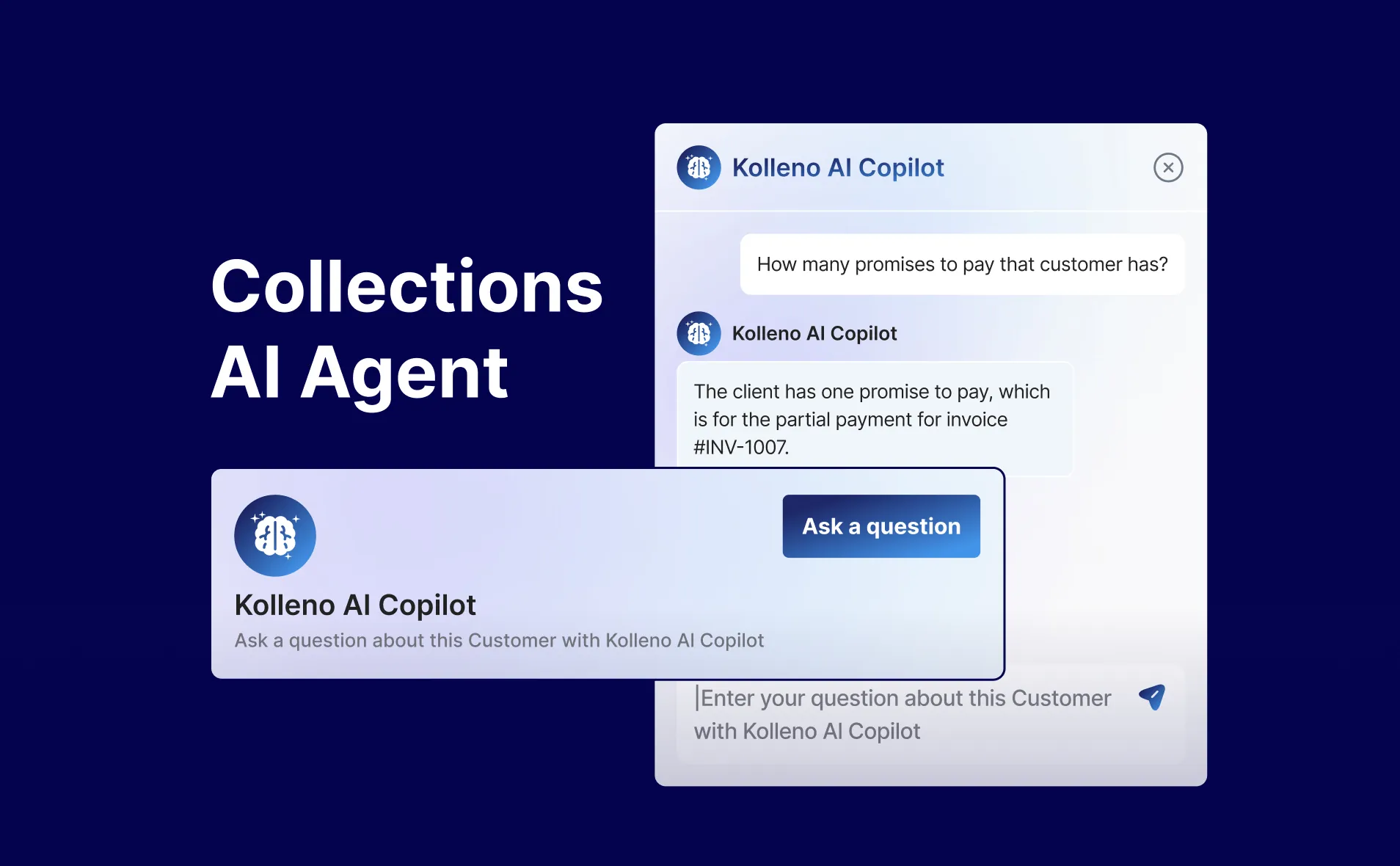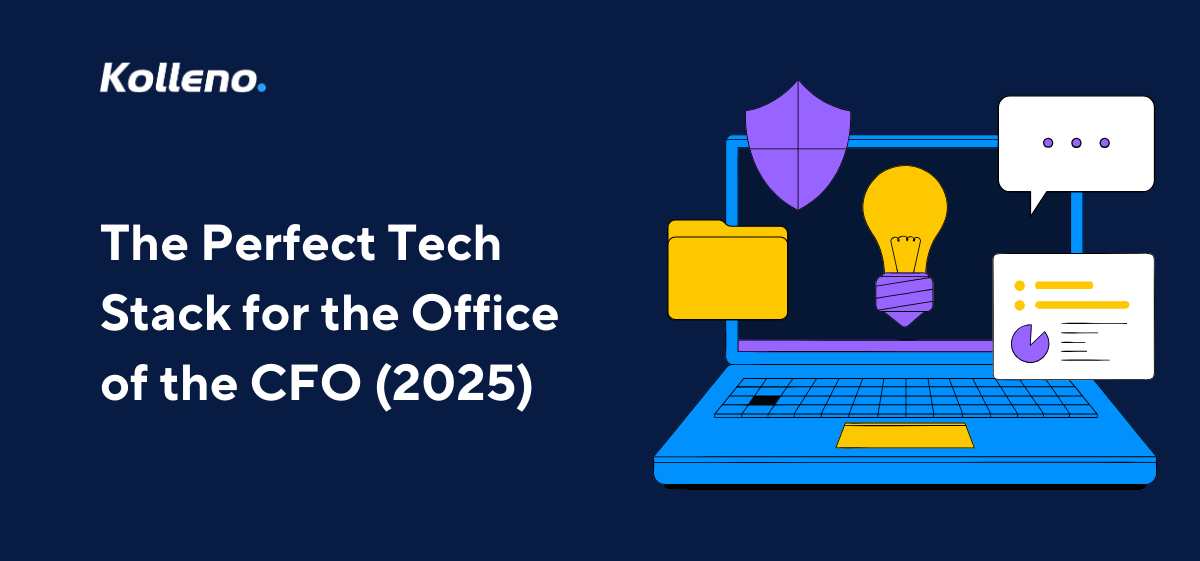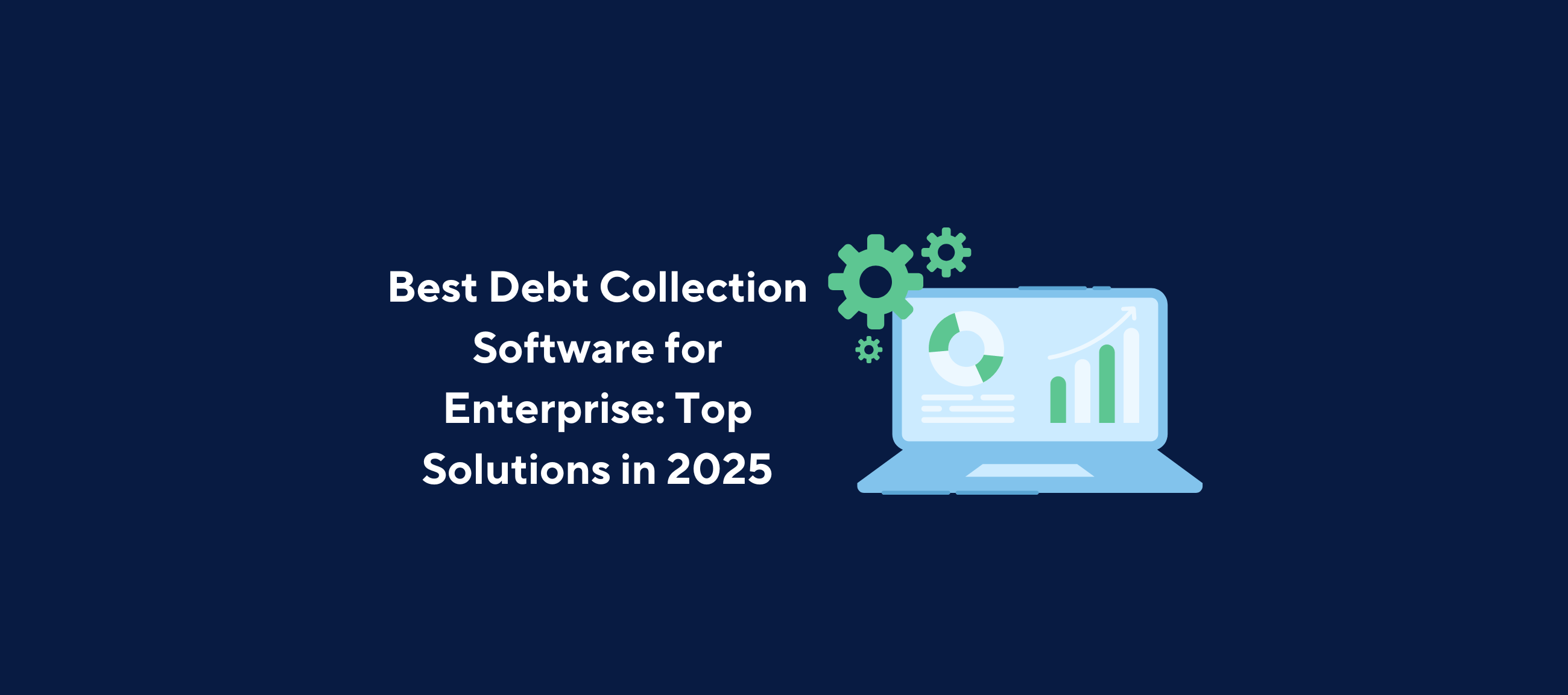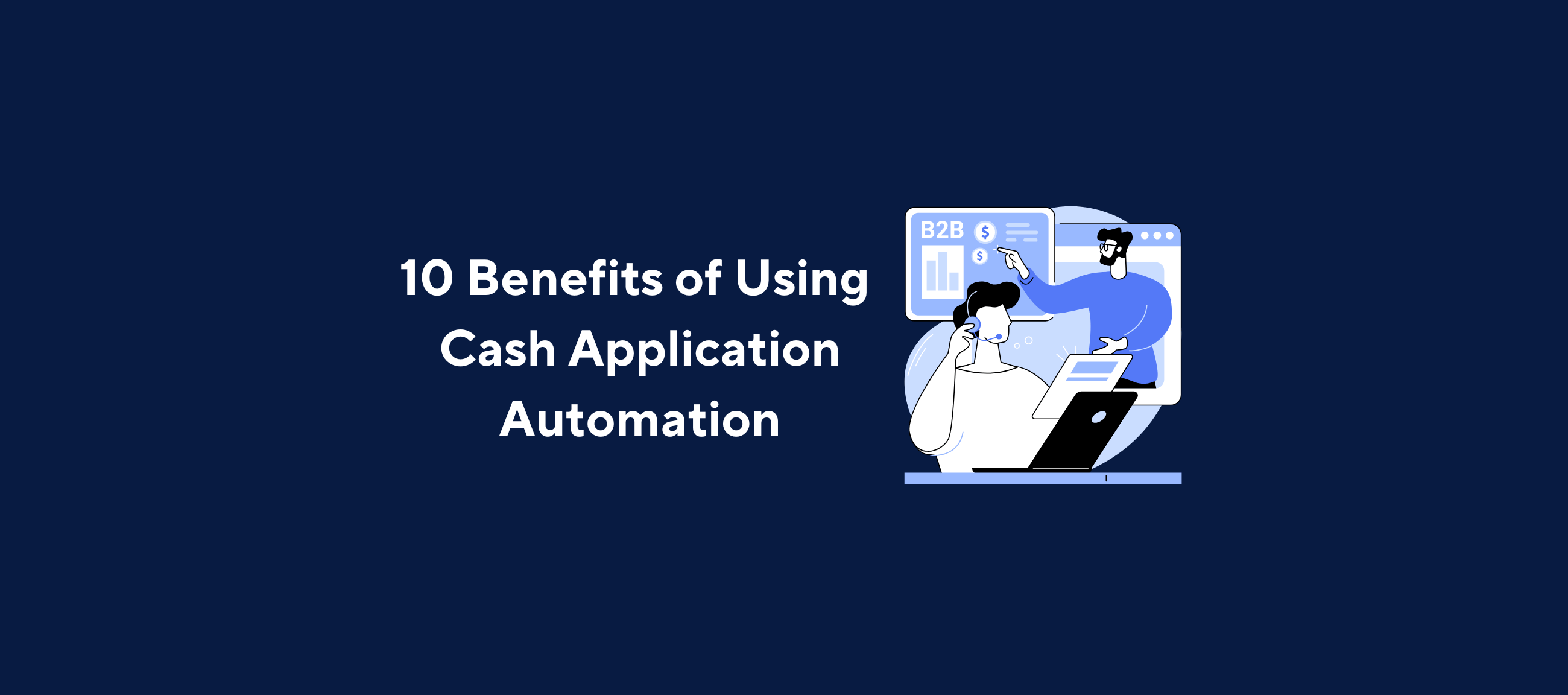The role of the Chief Financial Officer (CFO) has evolved significantly in recent years. Today’s modern CFO plays a key role in decision-making and driving business growth. This shift has required adopting a comprehensive CFO tech stack that can streamline workflows, enhance forecasting, and provide real-time insights into financial data.
According to Deloitte, “Gone are the days when CFOs focused only on providing accurate numbers to the organisation. With business and operating dynamics shifting, today’s CFOs are required to become more strategic, moving away from the role as financial partner to a more strategic partner to the CEO”.
The right tech stack allows finance teams to operate more efficiently and make data-driven decisions. From enterprise resource planning (ERP) systems to specialized accounting software, the options available today can transform the finance function.
In this article, we’ll explore the perfect tech stack for the CFO, focusing on tools that automate routine tasks, improve cash flow management, and support effective budgeting and financial planning.
Understanding the CFO’s Role
The Chief Financial Officer (CFO) plays a pivotal role in any organization. Traditionally, the CFO oversaw financial reporting, managed budgets, and ensured compliance with regulatory requirements.
However, with advancements in technology, the CFO’s role has expanded to include leveraging real-time insights for strategic decision-making. Modern CFOs act as strategic partners to the CEO and other executives, contributing to long-term planning, assessing financial risks, and guiding the company through complex financial landscapes.
“Being a CFO today means leveraging data and technology to drive strategic decisions. It’s about ensuring accuracy, embracing automation, and focusing on activities that propel the company forward.”
- Djibrane Larrabure, CFO of Kolleno
In today’s data-driven world, the ability to analyze and interpret financial data is crucial. CFOs must ensure their finance teams have access to the right tools and technologies to gather, process, and analyze data efficiently. This includes implementing business intelligence (BI) tools and data visualization software that enable quick and accurate decision-making. By harnessing the power of data, CFOs can identify trends, forecast future performance, and make informed decisions that align with the company’s strategic goals.
Of course, it’s vital to have the right data. A recent survey shows that 40% of global CFOs don’t completely trust the accuracy of their organization’s financial data. Without the right data, CFOs can‘t make the right decisions. It’s as simple as that.
If you do have accurate data, that’s where automation can help, playing a significant role in the modern CFO’s toolkit. By automating routine and time-consuming tasks such as accounts receivable, payable, and expense management, CFOs can free up their teams to focus on higher-value activities.
This increases efficiency and reduces the risk of errors, ensuring more accurate financial reporting and compliance. By understanding the evolving responsibilities of the CFO and the importance of a comprehensive tech stack, finance leaders can better support their organizations and drive long-term success.
Key Components of a CFO Tech Stack
A well-rounded CFO tech stack is crucial for streamlining financial operations and enabling strategic decision-making. The key components of this tech stack can be grouped into several categories:
- Core Financial Systems: These include essential tools such as ERP (Enterprise Resource Planning) systems and accounting software. ERP systems like NetSuite and SAP integrate various business processes, while accounting software like QuickBooks, Xero, Light ensure accurate financial reporting and bookkeeping.
- Automation and Workflow Optimization: Automation tools help finance teams streamline routine tasks such as accounts receivable, payable, and expense management. By automating these processes, CFOs can improve efficiency and reduce errors, allowing their teams to focus on strategic activities.
- Financial Planning and Analysis (FP&A): FP&A tools are critical for budgeting, forecasting, and variance analysis. These tools enhance the accuracy of financial plans and provide real-time insights, helping CFOs make informed decisions and adjust strategies as needed. The examples of such tools include Drivetrain, Mosaic and Abacum.
- Business Intelligence and Data Visualization: BI tools and data visualization software are essential for analyzing and presenting financial data. Tools like Tableau and Power BI help CFOs and finance teams understand complex data sets, identify trends, and make data-driven decisions.
- Budgeting and Forecasting Tools: These tools aid in creating accurate budgets and forecasts. Software like Anaplan allows for more precise financial planning, helping organizations allocate resources effectively and prepare for future growth.
- Cash Flow Management: Effective cash flow management is vital for maintaining the financial health of an organization. Tools like Pigment and Payflows provide real-time insights into cash flow can help CFOs monitor liquidity, manage expenses, and ensure the company can meet its financial obligations.
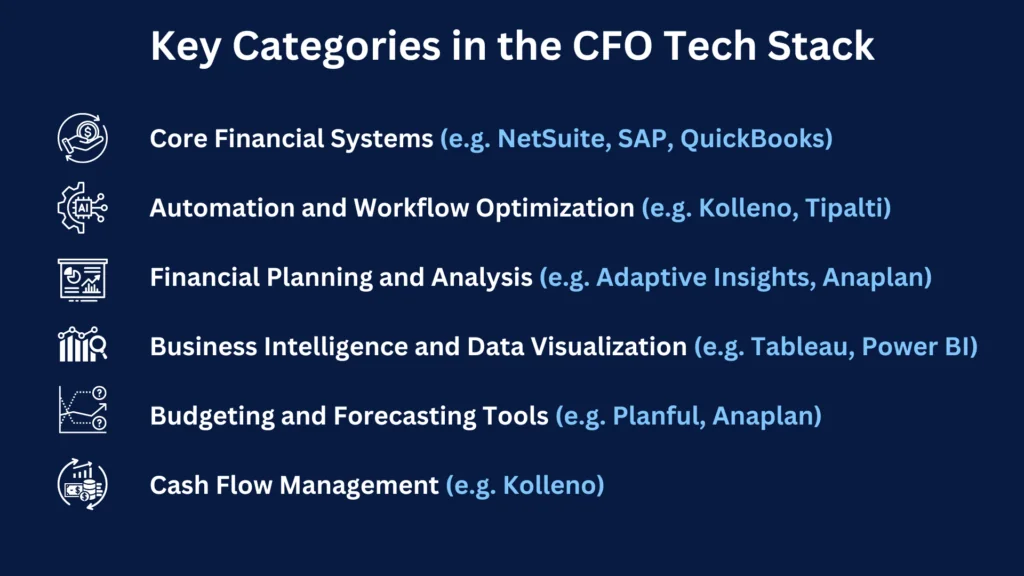
By integrating these key components into their tech stack, CFOs can enhance their finance functions, improve decision-making, and drive business success.
Core Financial Systems
Core financial systems form the backbone of any CFO tech stack. They include essential tools such as ERP (Enterprise Resource Planning) systems and accounting software. These systems are critical for ensuring accurate financial reporting, efficient management of financial operations, and compliance with regulatory requirements.
ERP Systems
ERP systems are vital for integrating various business processes into a single, unified system. The global ERP system market was worth an estimated $71.41 billion in 2023—showing just how critical they are to businesses globally.
But what makes ERP systems so special?
The best tools cover a wide range of functions, including finance, procurement, HR, and supply chain management. Popular ERP solutions like NetSuite, SAP, and Microsoft Dynamics offer comprehensive features that help streamline operations and improve efficiency across the organization.
The primary benefit of ERP systems is their ability to provide a centralized view of financial data. This holistic perspective allows CFOs to monitor financial performance in real-time, identify potential issues early, and make informed decisions. By consolidating data from different departments, ERP systems also reduce data silos, ensuring that all team members have access to consistent and accurate information.
Accounting Software
Accounting software is another crucial component of core financial systems. Tools like QuickBooks, NetSuite and Xero are designed to handle various accounting tasks, including bookkeeping, invoicing, payroll, and financial reporting. These software solutions simplify the management of day-to-day financial operations, allowing finance teams to work more efficiently.
Accurate bookkeeping and financial reporting are essential for maintaining the financial health of an organization. Accounting software ensures that all financial transactions are recorded correctly and can be easily retrieved for analysis. This accuracy is critical for compliance with regulatory requirements and for providing stakeholders with reliable financial information.
Moreover, modern accounting software often includes features for automating routine tasks, such as reconciling bank statements or generating financial reports. This automation reduces the likelihood of human error and frees up finance teams to focus on more strategic activities, such as analyzing financial data and providing insights to support business decisions.
Automation and Workflow Optimization
Automation and workflow optimization are key components of a modern CFO tech stack. They focus on streamlining routine tasks, reducing errors, and enhancing overall efficiency within the finance function.
Automation Tools
Automation tools like Tipalti are designed to handle repetitive and time-consuming tasks such as accounts receivable, accounts payable, and expense management. By automating these processes, finance teams can significantly reduce manual work, allowing them to focus on higher-value activities. Tools like Expensify can automate invoice processing, expense reporting, and payment approvals, ensuring accuracy and saving time.
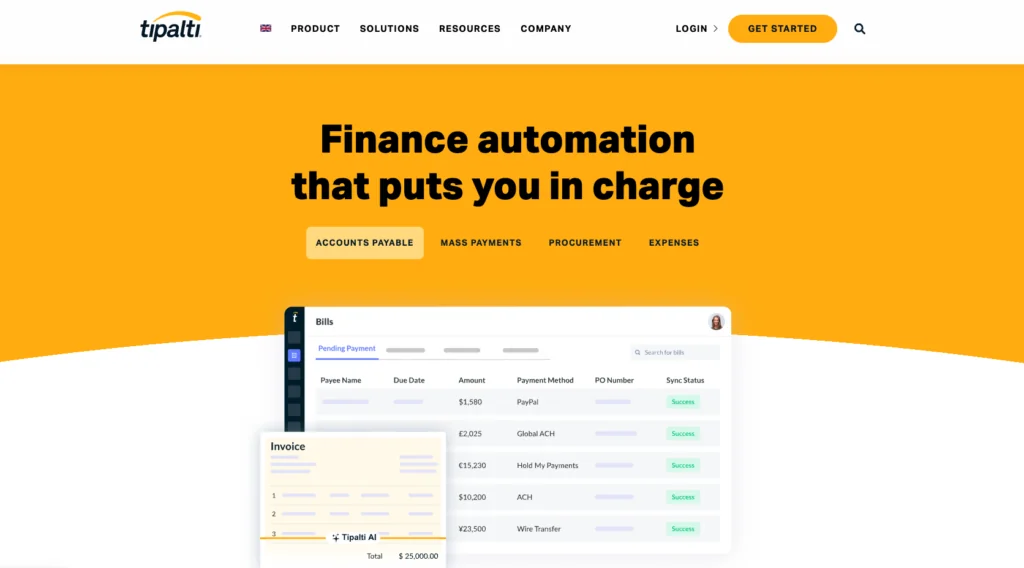
Workflow Optimization
Optimizing workflows involves improving the processes through which tasks are completed, ensuring they are efficient and effective. SaaS solutions like Trello and Asana help finance teams manage tasks and collaborate seamlessly. These tools provide visibility into project progress, assign responsibilities, and set deadlines, making it easier to track and complete tasks on time.
Kolleno, for example, developed drag and drop AI-driven collection workflows that allow finance teams to automate and optimise AR processes with automated trigger-based workflows that use machine learning to find and act on the best collection strategy, such as messaging customers who are most responsive by email at specific times like 4 PM. Finance teams use these workflows to not only automate but personalise customer engagement, dynamically adjusting workflows based on real-time data, predicting future payment behaviours, and seamlessly integrating with existing systems.
Financial Planning and Analysis (FP&A)
Financial Planning and Analysis (FP&A) is a crucial element of a CFO tech stack. It encompasses budgeting, forecasting, and variance analysis, all of which are essential for strategic planning and informed decision-making.
Budgeting and Forecasting Tools
FP&A tools like Drivetrain, Adaptive Insights and Anaplan are designed to enhance the accuracy of budgeting and forecasting. These tools allow finance teams to create detailed financial plans, model various scenarios, and predict future performance. By providing real-time data and insights, they enable CFOs to adjust strategies proactively.
Variance Analysis
Variance analysis is the process of comparing actual financial performance against budgeted figures. FP&A tools automate this analysis, making it easier to identify discrepancies and understand their causes. This helps CFOs pinpoint areas where the business is underperforming and take corrective actions.
Strategic Decision-Making
FP&A tools support strategic decision-making by providing comprehensive insights into the company’s financial health. They allow CFOs to analyze trends, monitor key metrics, and assess the financial impact of potential business decisions. With accurate and timely information, CFOs can make data-driven decisions that align with the company’s long-term goals.
Business Intelligence and Data Visualization
Business Intelligence (BI) and data visualization are key components of a CFO tech stack, allowing them to analyze and present financial data in a clear, actionable format.
Business Intelligence Tools
BI tools like Tableau and Power BI are designed to help finance teams gather, process, and analyze large volumes of financial data. These tools provide advanced analytics capabilities, allowing CFOs to uncover insights, identify trends, and make data-driven decisions. BI tools integrate with various data sources, ensuring comprehensive and accurate analysis.
Data Visualization Software
Data visualization software transforms complex data sets into intuitive visual formats such as charts, graphs, and dashboards. This makes it easier for CFOs and finance teams to interpret data quickly and communicate insights effectively. Tools like Tableau and Power BI offer customizable visualizations that can be tailored to meet the specific needs of the business.
Budgeting and Forecasting Tools
Budgeting and forecasting tools are essential components of a CFO tech stack, enabling precise financial planning and strategic decision-making.
Accurate Budgeting
Tools like Adaptive Insights and Anaplan streamline the budgeting process, allowing finance teams to create detailed, accurate budgets. These tools provide templates, automation, and collaborative features that make budgeting more efficient and less prone to errors. Accurate budgeting ensures that resources are allocated effectively and financial goals are met.
Enhanced Forecasting
Forecasting tools offer advanced modeling capabilities that help CFOs predict future financial performance. These tools allow for scenario planning, where different assumptions and variables can be tested to see their potential impact on the business. Enhanced forecasting helps CFOs anticipate challenges, identify opportunities, and adjust strategies proactively.
Real-Time Insights
Modern budgeting and forecasting tools provide real-time data and insights, which are crucial for timely decision-making. CFOs can access up-to-date financial information and adjust budgets and forecasts as needed. This agility allows for better responsiveness to changing market conditions and business needs.
Cash Flow Management
Did you know that a staggering 82% of US small businesses fail due to cash flow issues?
Effective cash flow management software is critical for maintaining the financial health and stability of any business. It makes it easy to track and analyze the inflows and outflows of cash to ensure the company can meet its financial obligations, invest in growth, and avoid liquidity issues. In other words, cash flow management keeps businesses alive.
Let’s dive into the key aspects and tools that make cash flow management an essential part of a CFO’s tech stack.
The Importance of Cash Flow Management
Cash flow management involves monitoring three primary components: operating cash flow, investing cash flow, and financing cash flow. By keeping a close eye on these areas, businesses can ensure they have enough liquidity to cover operational expenses, invest in new opportunities, and maintain a healthy financial position.
Effective cash flow management software supports better decision-making, reduces the risk of insolvency, and provides a solid foundation for negotiating with suppliers and lenders. There’s a reason Richard Branson said “Never take your eyes off the cash flow because it’s the life blood of business.”
Tools for Managing Cash Flow
Modern cash flow management tools offer automation and real-time insights, which are crucial for maintaining an accurate picture of a company’s financial health. For example, Kolleno is a powerful tool that automates accounts receivable (AR) processes, significantly improving cash flow stability.
By using Kolleno, businesses can reduce overdue payments and streamline the invoicing process. Kolleno’s features, such as automated reminders and payment portals, help ensure timely payments—especially when combined with payment processing tools like GoCardless. Using these solutions significantly enhances organizations’ overall financial efficiency.
Conclusion
In conclusion, the role of the CFO has transformed from traditional financial stewardship to being a strategic partner in business growth. To thrive in this evolved role, CFOs must leverage a comprehensive tech stack that integrates core financial systems, automates workflows, enhances financial planning and analysis, and provides real-time business intelligence and cash flow management.
A well-chosen tech stack empowers CFOs to streamline operations, improve accuracy, and make data-driven decisions that align with the company’s strategic goals. From ERP systems and accounting software to automation tools and advanced FP&A solutions, the right combination of tools can significantly enhance the efficiency and effectiveness of the finance function.
For CFOs looking to optimize their cash flow management, Kolleno offers a robust solution that automates accounts receivable processes, reduces overdue payments, and provides valuable insights into financial health. By integrating Kolleno into your tech stack, you can ensure timely payments, enhance financial stability, and focus more on strategic growth initiatives.
Take the next step in transforming your finance operations.
Try Kolleno today and experience the benefits of streamlined cash flow management.
